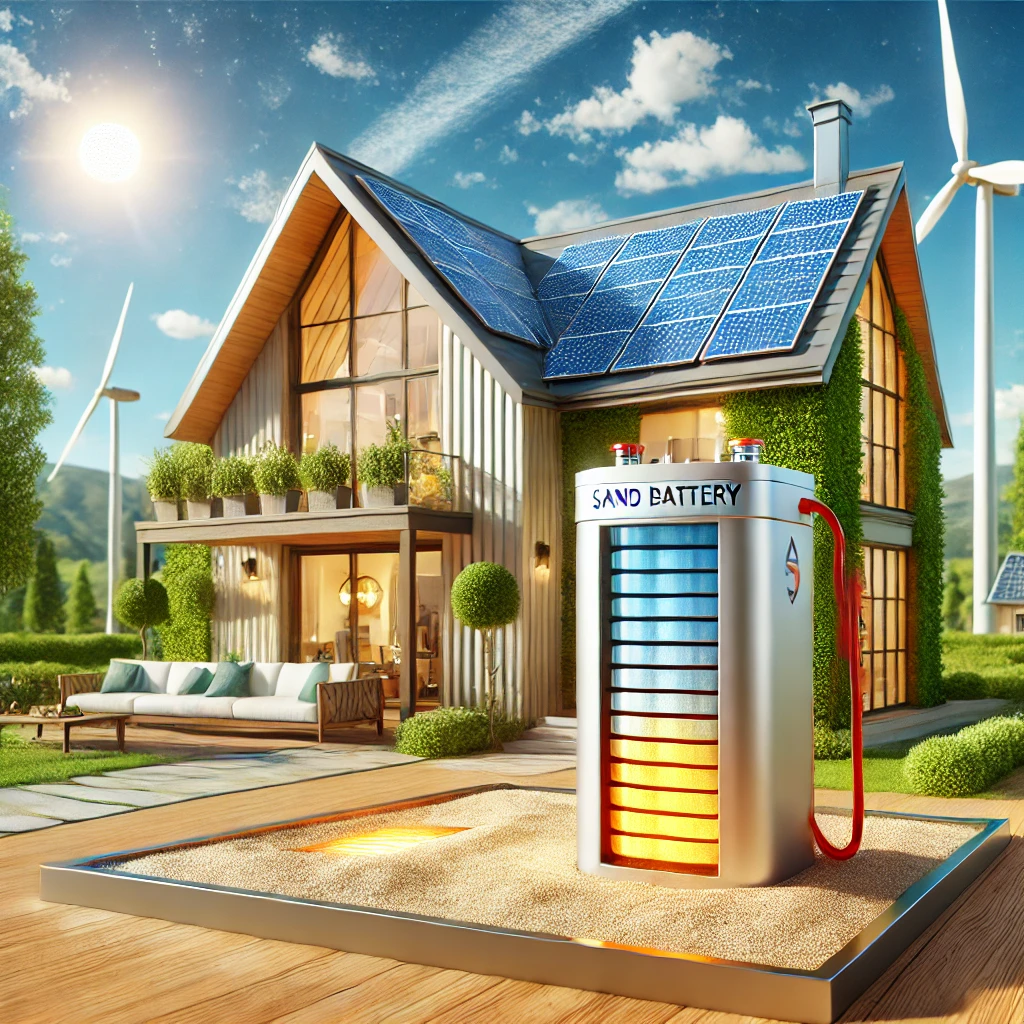Introduction: A New Era in Energy Storage
As the world shifts toward renewable energy sources like solar and wind, a major challenge remains—energy storage. Traditional battery technologies, like lithium-ion, are expensive, have limited storage capacity, and degrade over time. But what if the solution to efficient, long-term energy storage was something as simple as sand?
A breakthrough in energy storage technology, sand batteries, is proving to be a game-changer. These batteries can store energy for months, making them an ideal solution for homes looking to harness renewable energy efficiently. This article explores how sand batteries work, their advantages, and why they could revolutionize home energy storage.
Understanding Sand Batteries: How Do They Work?
A sand battery is essentially a thermal energy storage system that uses sand as its medium. It works in the following steps:
- Energy Absorption – Excess renewable energy, such as solar or wind power, is used to heat the sand to extremely high temperatures, often between 300°C and 600°C (572°F – 1112°F).
- Thermal Storage – The sand, contained within an insulated chamber, retains this heat for long periods—potentially months without significant loss.
- Energy Retrieval – When needed, the stored heat can be converted back into electricity (via steam turbines) or used for direct heating applications in homes and buildings.
This system is ideal for seasonal energy storage, allowing homes to collect solar energy in summer and use it during the cold winter months.
Why Sand Batteries Could Transform Home Energy Storage
1. Long-Term Energy Storage
One of the biggest limitations of lithium-ion batteries is that they store energy for a short duration, typically a few hours to a couple of days. Sand batteries, on the other hand, can store energy for months, making them perfect for long-term energy use.
2. Cost-Effective and Sustainable
- Abundant Material – Sand is widely available, non-toxic, and does not require environmentally damaging mining like lithium or cobalt.
- Lower Production Costs – Since sand is inexpensive and the system has fewer complex components, it has the potential to be much cheaper than lithium-ion batteries.
3. Increases Energy Independence
For homeowners with solar panels, sand batteries can store summer energy for winter use, reducing reliance on the grid and lowering electricity bills.
4. Supports the Renewable Energy Transition
Renewable energy sources like solar and wind are intermittent, meaning they don’t always produce power when it’s needed. Sand batteries can store excess energy and release it when demand is high, balancing supply and demand effectively.
5. Reduces Environmental Impact
Unlike lithium-ion batteries, sand batteries do not involve hazardous chemicals, reducing the risk of toxic waste and environmental degradation.
Real-World Applications: Sand Batteries in Action
One of the most promising real-world implementations of sand batteries comes from Polar Night Energy, a Finnish company that developed a fully operational sand battery system. Their system, installed in the Finnish city of Kankaanpää, can store up to 8 megawatt-hours (MWh) of thermal energy at over 600°C and supply heat to nearby homes.
This success proves that sand batteries are not just theoretical but a viable and scalable solution for home and community energy storage.
Comparison: Sand Battery vs. Lithium-Ion Battery
| Feature | Sand Battery | Lithium-Ion Battery |
|---|---|---|
| Storage Duration | Months | Hours to Days |
| Efficiency | High for heat storage, moderate for electricity conversion | High for electricity storage |
| Cost | Lower (cheap materials) | High (expensive metals) |
| Environmental Impact | Low (abundant, non-toxic materials) | High (toxic mining waste) |
| Lifespan | Decades | 5-10 years |
Challenges and Limitations
While sand batteries have immense potential, they also face some challenges:
- Size and Space Requirements – Large-scale sand batteries require considerable space, which may not be ideal for smaller homes.
- Electricity Conversion Efficiency – While excellent for heat storage, current methods of converting stored heat into electricity are less efficient than direct electrical storage.
- Limited Awareness and Adoption – The technology is still relatively new, and mass adoption will require investment and policy support.
Future of Sand Batteries in Home Energy Storage
With continued research and technological advancements, sand batteries could become a mainstream home energy storage solution. If integrated with smart home systems and improved heat-to-electricity conversion technology, they could significantly reduce energy costs and dependence on fossil fuels.
Governments and companies worldwide are investing in renewable energy storage, and sand batteries could be a key player in creating self-sufficient, green homes of the future.
Conclusion: A Game-Changer for Home Energy Storage
Sand batteries represent a revolutionary step forward in energy storage. They provide a sustainable, long-lasting, and cost-effective alternative to conventional batteries, making them ideal for homeowners looking to store renewable energy efficiently.
With their ability to store energy for months, sand batteries could help solve one of the biggest challenges in the renewable energy sector—reliable, long-term energy storage.
As more research and real-world implementations emerge, we may soon see sand batteries powering homes worldwide, ushering in a cleaner, more sustainable energy future.
References
- Polar Night Energy. “World’s First Sand Battery in Operation.” Available at
- Science Direct. “Thermal Energy Storage Using Sand.” Research Article
- National Renewable Energy Laboratory (NREL). “Advancements in Thermal Energy Storage.” Government Report
Would you consider using a sand battery in your home? Share your thoughts in the comments!









+ There are no comments
Add yours